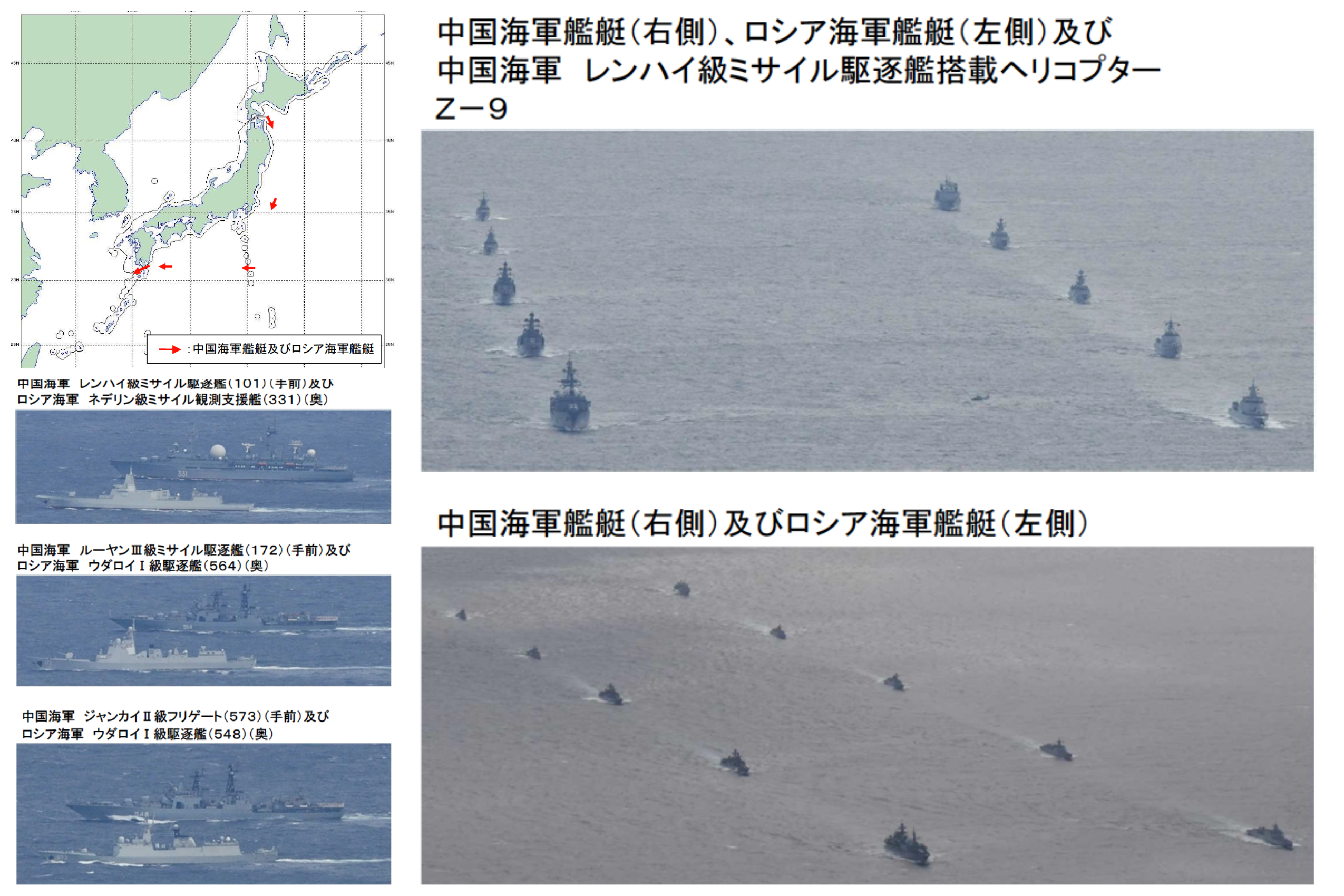
KUALA LUMPUR – A combined Russian Navy and People’s Liberation Army Navy (PLAN) fleet concluded a sail in international waters east of Japan’s main island of Honshu and split off to their home ports on Saturday, all while being monitored by Japan Maritime Self-Defense Force ships and aircraft during the voyage.
The Chinese ships were Type 055 destroyer Nanchang (101), Type 052D destroyer Kuming (172), Type 054 frigates Binzou (515) and Liuzhou (573) and the replenishment ship Dongpinghu (902). Russian ships were destroyers Admiral Tributs (564) and Admiral Panteleyev (548), corvettes Gromkiy (335) and Hero of the Russian Federation Aldar Tsydenzhapov (339) and the missile range instrumentation ship Marshal Krylov (331).
The combined fleet had entered the Tsugaru Strait on Oct. 18 and since then had been sailing off Honshu. The Joint Staff of the Japan Self-Defense Force issued a release and map on Saturday stating that the joint fleet had sailed through the Osumi Strait that day. Located between the Osumi Peninsula and Tanegashima Island, the strait connects the Sea of Japan with the Pacific Ocean. Following their sail through the Osumi Strait, the ships of the two countries separated at a location 130 kilometers, or about 81 miles, southeast of the Danjo Islands. The Joint Staff release said destroyer JS Yamagiri (DD-152) and the destroyer escort JS Tone (DE-234) conducted surface ship monitoring, while P-1s from Fleet Air Wing 1 operating from Kanoya Air Base, Kyushu carried out aerial surveillance. Japan Air Self-Defense Force fighter aircraft were scrambled in response to helicopter activities from the Russian and Chinese ships.
Both the Russian and Chinese defense ministries issued statements on Saturday at the conclusion of the joint sail. The Russian Defense Ministry statement noted that this was the first time the countries had conducted joint patrols in the Western Pacific.
“[T]he tasks of the patrol were to demonstrate the state flags of Russia and China, maintain peace and stability in the Asia-Pacific region, as well as protect the objects of maritime economic activity of the two countries,” the Russian defense ministry said in its statement.
Meanwhile, the Chinese Defense Ministry statement said that “during the cruise, the joint formation strictly abide by the relevant provisions of international law and did not enter the territorial waters of other countries. This joint maritime cruise aims to further develop the China-Russia comprehensive strategic partnership in the new era, enhance the joint action capabilities of both parties, and jointly maintain international and regional strategic stability.”
Japan continues to monitor the movement of the Russian ships and issued a Joint Staff release on Monday stating that the Russian ships had sailed through the Tsushima Strait to the Sea of Japan and were 60 kilometers, or about 37 miles, northeast of Tsushima as of 10 a.m. on Oct. 24. The statement added that missile boat JS Otaka (PG-826), along with JS Tone (DE-234) were conducting surface ship surveillance of the Russian fleet, while the P-1s from Fleet Air Wing 1 operating from Kanoya Air Base, Kyushu and Fleet Air Wing 4 operating from Naval Air Facility Atsugi, Honshu conduct aerial surveillance. JASDF fighter aircraft were also scrambled in response to helicopter activity from the Russian ships.
Meanwhile, Chinese officials called for U.S. forces to cease freedom of navigation operations in the South China Sea.
“For a long time, the US military has frequently dispatched aircraft carriers, strategic bombers, nuclear submarines and other advanced weapon systems to show muscles and stir up troubles in the South China Sea,’” Chinese Ministry of Defense spokesman Senior Colonel Tan Kefei said last week.
“The so-called ‘freedom of navigation and overflight’ by the United States is essentially a cover for the United States to challenge the rights and interests of other countries by virtue of its powerful maritime power.”





